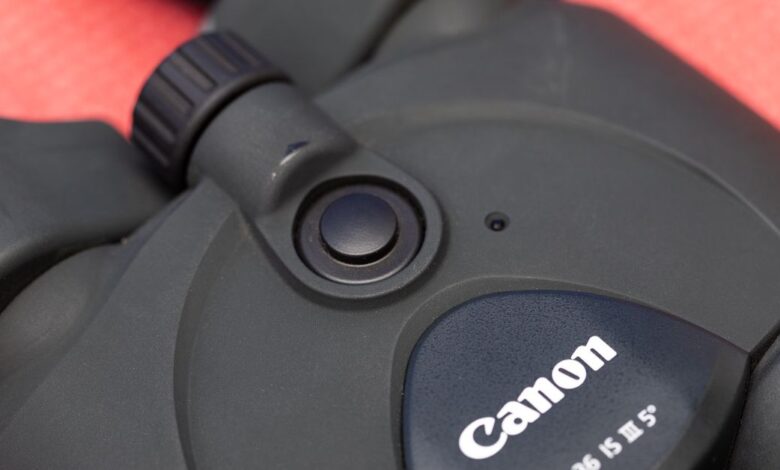The button on Canon’s image-stabilized binoculars unlocked superhuman sight

From pirates to spies to kid detectives, it’s a common Hollywood trope: hold a simple spyglass or binoculars up to your eyes, and you’ll get a crystal-clear cylindrical picture of what’s going on.
That’s horseshit, of course. Unless you’ve got the hands of a surgeon, it’s surprisingly hard to line up eyeballs, multiple pieces of glass, and a faraway subject. Kid Sean was sad to learn that fact. But I’ll never forget the day Teen Sean pressed the magic button that made all the difference: the button atop the image-stabilized binoculars that Canon still sells today.
A family friend was showing me his new toy at the beach, and I couldn’t understand what was so special about it. (I’m blessed with 20/20 eyesight, and I figured I could already see the swimsuit-clad ladies just fine — why would I want to add complications?) He told me I wasn’t holding down the button.
What button? Oh, this button.
Suddenly, I was there, right next to the crashing waves, marveling at the sparkles coming off the sand. For the first time, I had Legolas-vision. Where had this been all my life?
When you press this button, a computer chip reads the data off built-in accelerometers to figure out your hand shake, then bends a prism filled with liquid inside each lens to counteract that wobble. It all runs off a pair of AA batteries.
The other week, I borrowed a pair of Canon’s 12×36 IS III binoculars for a stroll down memory lane, and it was almost exactly the way I remembered. The best way I can think to describe: it’s like you’ve teleported 100, 200, even 300 feet closer to what you’re looking at. (I even brought my measuring wheel to the park to check.)
The actual button is kind of terrible, though? It’s a soft rubber nipple with an even softer membrane underneath that provides zero feedback. There’s no satisfying click, and it’s easy to let it go without realizing. It takes a bit of force to hold it down and keep the image stabilization active. Newer models let you just tap a firmer button, I hear.
Either way, as long as it’s held down and you’re focused correctly, the world comes into sharp relief. I got “up close” to a red squirrel without any fear of scaring it away, admiring how its bushy coat was clearly made of individual hairs. I spotted a knothole in a tree, surrounded by crispy yet furry bark, from 40 meters away. I admired the front yard of a house on the street surrounding the park, even though half the park was between that house and me.
At home, I was able to clearly make out my whole living room in the reflection of one of the ornaments on our Christmas tree from the other side of the room. I wish I could take a photo that does it justice, but I couldn’t keep my phone as still as I’d like, and the phone’s camera is wider-angle than the human eye anyhow. Here’s the best I got completely handheld — imagine this zoomed in, nearly as clear as can be:
Canon wasn’t the first to put image stabilization in binoculars — even a cursory search suggests gyro versions have been around since at least the ’60s for military and professional purposes, and Leica sold a completely mechanical pair in 1990.
But it does seem like Canon may have created the consumer / prosumer category where modern IS is concerned. The company introduced its first pair in 1995, calling the original 12×36 IS “the world’s first and only affordable binoculars with image stabilization.” And despite their $1,599 sticker price, publications like Boating Magazine tested them alongside binoculars with no IS at all, marveling at how much more zoom you could get while afloat. “Most marine binocs are 7×50. That’s about the max before moving images begin to leave the lenses,” it wrote at the time.
Today, the 12×36 IS costs $799 — still a hefty price, but a lot less than the $3,100 the original would have cost in today’s money.
If you do decide to buy or rent a pair, be sure to check out their closest focusing distance (CFD) or minimum focusing distance (MFD) spec before you pay, because it’s easy to get more magnification than you want or need. Canon’s 12×36, for example, simply can’t focus on anything closer to you than 20 feet (six meters) away.
Also, I’m a little surprised the category hasn’t evolved more since I was a teen. Why can’t I find image-stabilized binoculars with a built-in camera or at least a smartphone lens adapter? What about modern autofocus in addition to the focus dial? Some cheap-o binoculars have shipped with a built-in camera, but I’m not seeing serious ones with image stabilization.
Perhaps that’s good news. There’s still room for a company to make the ultimate binoculars.
Source link






